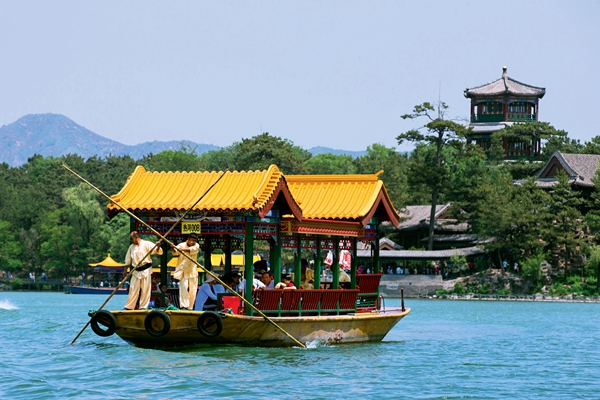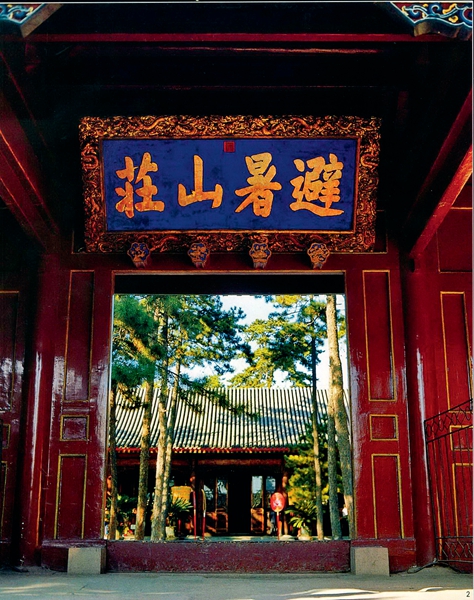Tips in Chengde
 0 Comment(s)
0 Comment(s) Print
Print E-mail China Today, July 17, 2017
E-mail China Today, July 17, 2017
Chengde Mountain Resort:
The resort showcases the best features of classical Chinese gardens, and is considered, along with the Forbidden City in Beijing and Confucius’ Temple in Qufu, among the top three imperial architectural complexes in China. The Mountain Resort superbly combines refined but luxuriant gardens and rolling mountains, and features 120 examples of classic period architecture.


Emperor Kangxi and Emperor Qianlong each named 36 of the resort’s 72 famous scenic spots. Buildings in the complex are tastefully laid out and constructed in ways that complement the terrain, so creating a harmonious scenic backdrop. Different from the palaces in the Forbidden City, with their yellow tiles, red walls and gorgeous paintings on the ceiling and beams, the Mountain Resort palaces and walls are built mainly of gray bricks and natural timber, so conveying stark elegance. The complex represents a perfect fusion of northern architectural techniques and southern agricultural style.
Transportation: Bus No.5, 10, or 15.
The outlying temples around the Mountain Resort that are open to visitors include the Puning Temple, Putuo Zongcheng Temple, Xumi Fushou Temple, Pule Temple, and Anyuan Temple.

Puning Temple, which means Temple of Universal Peace, is a famous site in North China for Buddhist activities. It is an ideal place to learn and study Buddhist culture.
Putuo Zongcheng Temple was modeled after the Potala Palace in Tibet. It is hence also known as the “mini Potala.” Covering the largest area of all temples around the Mountain Resort, Putuo Zongcheng was originally dedicated to Emperor Qianlong at the celebration of his 60th birthday. Dalai Lamas also stayed here on their visits to the Qing emperors in Chengde.
Xumi Fushou Temple was originally built for the Sixth Panchen Lama. He came from Tibet to Chengde to convey his congratulations at the birthday celebration of Emperor Qianlong.
Anyuan Temple, also known as Ili Temple, was built for the 2,000 migrants of a Mongolian tribe from Xinjiang to conduct religious activities in Chengde.
Pule Temple, literally the Temple of Universal Happiness, was built to commemorate the return to the motherland of ethnic groups such as the Turgut. The main building is Xuguang Pavilion, a gabled circular construction highly reminiscent of the Hall of Prayer for Good Harvests in Beijing’s Temple of Heaven. Within the main pavilion is a statue of Mandkesvara, or Yab-yum, of Esoteric Buddhism.
Transportation: The outlying temples are in the east and north of Chengde and also near the city center. Transportation is convenient. Visitors can take bus No. 6 to Puning Temple, Putuo Zongcheng Temple, and Xumi Fushou Temple, and bus No. 10 to Pule Temple and Anyuan Temple.
Bashang Grasslands
The Bashang Grasslands comprise Weichang Bashang (Mulan Hunting Ground), Fengning Bashang, Zhangbei Bashang, and the Heavenly Road. They form an important part of the Inner Mongolian Plateau. Among them, Fengning Bashang is the nearest to downtown Beijing, and Mulan has the most breathtaking views. The latter sits at the junction of the Inner Mongolian Plateau and mountainous areas of northern Hebei Province, where forests meet meadows. It is cool in summer, and encompasses vast grasslands dotted with colorful flowers. At midwinter visitors can enjoy views of snow-capped mountains and grassland.

The best season to visit the grassland is from July to October. Due to the high altitude and big differences in day and night temperatures, visitors are advised to bring warm clothing.
Transportation: Take a train or coach to Mulan Hunting Ground from Beijing or Chengde. We recommend a self-driving tour.






Go to Forum >>0 Comment(s)